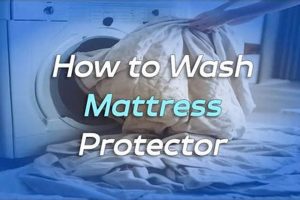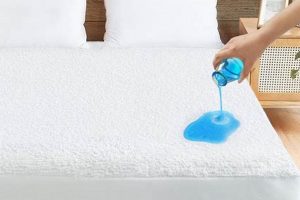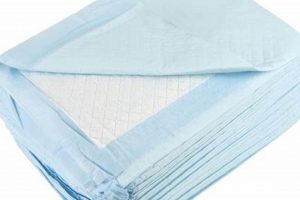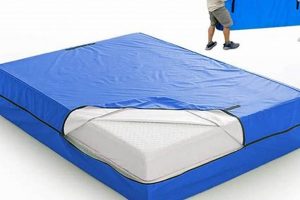A barrier designed to shield a bed’s primary sleeping surface from liquids, stains, allergens, and dust mites. Functionally, it acts as a safeguard, extending the lifespan and maintaining the hygiene of the underlying mattress. For instance, a spill of coffee on the bed will be absorbed by the protector, preventing it from penetrating and damaging the mattress core.
Utilizing such a shield offers considerable benefits. It helps to maintain a cleaner sleeping environment by preventing the accumulation of allergens and dust mites, which can exacerbate respiratory issues. Moreover, it safeguards any warranty the mattress carries, as most warranties are voided by stains or damage to the mattress. Historically, simpler versions were used, evolving into more technologically advanced, breathable, and waterproof materials available today.
The following sections will further explore the various types available, considerations for selection, and address common concerns regarding their use and maintenance.
Guidance on Mattress Protection
Selecting and utilizing a mattress protector requires careful consideration to ensure optimal protection and longevity of the mattress investment.
Tip 1: Prioritize waterproof or water-resistant options, particularly for households with children, pets, or individuals prone to spills. This will prevent liquids from penetrating the mattress core, avoiding potential damage and voiding warranties.
Tip 2: Assess the breathability of the material. Non-breathable protectors can trap heat and moisture, creating an uncomfortable sleeping environment. Look for materials like cotton, bamboo, or specifically designed breathable synthetics.
Tip 3: Consider the presence of allergens. If allergies are a concern, opt for a protector specifically designed to block dust mites and other allergens. Ensure it is hypoallergenic and certified by a reputable organization.
Tip 4: Measure the mattress depth accurately before purchase. Protectors are available in various depths, and selecting the wrong size can result in a poor fit, reducing effectiveness and potentially damaging the protector itself.
Tip 5: Review the care instructions carefully. Different materials require different cleaning methods. Following the manufacturer’s instructions will ensure the protector remains effective and prolongs its lifespan.
Tip 6: Evaluate the material’s composition and construction. A protector with a durable and well-constructed design will offer better protection and last longer than a cheaply made alternative.
Ultimately, selecting the appropriate protection involves balancing the need for safeguarding against spills and allergens with the desire for a comfortable and hygienic sleep environment.
The subsequent sections will offer a summary of the various types of mattress protectors and address frequently asked questions.
1. Warranty Protection
Mattress warranties typically provide coverage against manufacturing defects. However, these warranties often include clauses that can be voided under specific conditions. Maintaining the validity of a mattress warranty is a critical consideration when evaluating the utility of a mattress protector.
- Stain Exclusion
Most mattress warranties explicitly exclude coverage for stains resulting from spills, bodily fluids, or other sources. The presence of a stain, regardless of its origin, may invalidate the warranty. A protector acts as a physical barrier, preventing stains from reaching the mattress surface and thereby preserving warranty coverage.
- Damage Due to Moisture
Warranties typically do not cover damage caused by moisture penetration. Excessive moisture can lead to mold and mildew growth within the mattress, compromising its structural integrity and hygiene. A waterproof or water-resistant protector safeguards against moisture intrusion, mitigating the risk of warranty voidance due to moisture-related issues.
- Proper Care and Maintenance
Mattress manufacturers often stipulate that proper care and maintenance are prerequisites for warranty claims. This can include using appropriate bedding and taking preventative measures against damage. Utilizing a protector demonstrates proactive care and adherence to recommended maintenance practices, strengthening the legitimacy of potential warranty claims.
- Burden of Proof
In the event of a warranty claim, the onus may be on the owner to demonstrate that the mattress was properly cared for and protected. A mattress protector serves as tangible evidence of preventative measures taken to maintain the mattress’s condition, simplifying the claims process.
In summary, employing a mattress protector is a prudent measure to safeguard a mattress warranty. By mitigating the risks of stains, moisture damage, and other factors that can void coverage, a protector can prove to be an invaluable investment in maintaining the long-term value and protection afforded by the manufacturer’s warranty.
2. Allergen Barrier
The presence of allergens within the sleeping environment can significantly impact respiratory health and overall sleep quality. The mattress, due to its porous nature and direct contact with the body, can become a reservoir for various allergens. Therefore, the protective function as an allergen barrier is a pivotal consideration.
- Dust Mite Proliferation
Dust mites thrive in warm, humid environments, readily colonizing mattresses. These microscopic organisms and their fecal matter are potent allergens, triggering allergic reactions and asthma symptoms in susceptible individuals. A mattress protector specifically designed to be dust mite-proof creates a physical barrier, preventing these allergens from accumulating within the mattress and minimizing exposure.
- Pet Dander Accumulation
Pet dander, consisting of microscopic skin flakes shed by animals, is a common household allergen. Mattresses can trap pet dander, even in pet-free homes, due to airborne transfer. A mattress protector provides a smooth, non-porous surface that pet dander cannot easily penetrate, facilitating easier cleaning and reducing allergen levels.
- Mold and Mildew Growth
Moisture accumulation within a mattress, whether from spills, sweat, or high humidity, can create a favorable environment for mold and mildew growth. Mold spores are known allergens and can exacerbate respiratory issues. A waterproof or water-resistant mattress protector prevents moisture from reaching the mattress core, inhibiting mold and mildew development and reducing allergen exposure.
- Pollen Retention
Pollen grains, carried into the home on clothing and hair, can settle onto bedding and mattresses. For individuals with pollen allergies, this exposure can trigger allergic reactions during sleep. A mattress protector provides a barrier that prevents pollen from embedding deep within the mattress fibers, making it easier to remove pollen through regular washing.
The implementation of a mattress protector, specifically one with allergen-blocking properties, is a proactive approach to mitigate allergen exposure within the sleeping environment. By addressing the various sources of allergens that can accumulate in a mattress, a protector contributes to improved respiratory health and enhanced sleep quality.
3. Spill Prevention
The capability of a mattress to withstand liquid intrusion is paramount in maintaining its integrity and hygiene over time. Spill prevention, therefore, represents a primary function to consider when assessing the utility of a mattress protector.
- Barrier Against Accidental Spills
A common occurrence in households is accidental spills, whether from beverages, bodily fluids, or other sources. A mattress protector acts as a physical barrier, preventing these liquids from penetrating the mattress fibers. Without protection, spills can lead to permanent staining, odor development, and the potential for mold or mildew growth within the mattress core.
- Protection for Children and Infants
In households with young children or infants, the likelihood of spills and accidents is elevated. Bedwetting, formula spills, and other incidents are commonplace. A waterproof mattress protector is essential in these situations, safeguarding the mattress from urine, vomit, and other liquids that can cause significant damage and hygiene concerns.
- Safeguarding Mattress Warranty
As previously mentioned, mattress warranties typically exclude coverage for damage caused by spills or moisture. Preventing spills from reaching the mattress is crucial for maintaining the validity of the warranty. A protector provides this safeguard, ensuring that the warranty remains intact in the event of other covered defects.
- Maintenance of Hygiene and Cleanliness
Spills, if not properly addressed, can create an unsanitary environment within the mattress. Bacteria and mold can thrive in moist conditions, leading to unpleasant odors and potential health risks. A mattress protector not only prevents spills from penetrating but also facilitates easier cleaning and maintenance, promoting a more hygienic sleep surface.
The implementation of a mattress protector as a spill prevention measure directly contributes to the overall longevity, hygiene, and value of the mattress investment. By mitigating the risks associated with liquid intrusion, the protector ensures a cleaner, healthier, and more durable sleeping surface.
4. Bed bug defense
The proliferation of bed bugs presents a significant challenge to maintaining a hygienic sleeping environment. Mattresses, with their intricate seams and crevices, offer ideal harborage for these pests. A mattress protector, specifically designed with bed bug defense in mind, functions as a critical barrier to prevent infestation and facilitate eradication efforts. This protective measure encases the mattress, denying bed bugs access to their preferred hiding places within the mattress core. The smooth, impenetrable surface of a bed bug-proof protector also hinders their ability to grip and move, further discouraging colonization. Consider a scenario where an individual unknowingly brings bed bugs into the home via luggage or clothing. Without a protector, these pests can quickly establish themselves within the mattress, leading to a full-blown infestation requiring professional intervention.
Effective bed bug defense relies on selecting a protector specifically labeled as “bed bug proof.” These protectors are typically constructed from tightly woven materials with sealed seams and secure zippers, preventing bed bugs from penetrating or escaping. Regular inspection of the protector for any signs of damage, such as tears or punctures, is crucial to maintaining its effectiveness. If an infestation is suspected, encasing the mattress with a bed bug-proof protector can help contain the pests and prevent them from spreading to other areas of the home. This containment strategy is often employed in conjunction with other eradication methods, such as heat treatment or insecticide application, to ensure complete elimination of the infestation.
In summary, a mattress protector designed for bed bug defense is an essential component of a comprehensive pest management strategy. It serves as a proactive measure to prevent infestation, a containment tool during eradication efforts, and an ongoing safeguard to protect the mattress from future colonization. The selection of a certified bed bug-proof protector, coupled with regular inspection and maintenance, offers a practical and effective means of mitigating the risks associated with bed bug infestations, thus promoting a healthier and more secure sleeping environment.
5. Hygiene maintenance
The preservation of a clean and sanitary sleep environment is a fundamental aspect of overall health and well-being. Mattress hygiene, in particular, necessitates proactive measures to prevent the accumulation of contaminants and maintain a consistently sanitary surface. A key component in achieving this standard is the utilization of a suitable barrier.
- Moisture Control
Perspiration, bodily fluids, and accidental spills can permeate a mattress, creating a breeding ground for bacteria and mold. A waterproof or water-resistant protector prevents moisture from reaching the mattress core, inhibiting microbial growth and maintaining a drier, more hygienic surface. This is especially critical in humid environments or for individuals prone to night sweats.
- Allergen Reduction
Mattresses can accumulate allergens such as dust mites, pet dander, and pollen. These allergens can trigger respiratory issues and allergic reactions. A protector with allergen-blocking properties creates a barrier, preventing these allergens from embedding within the mattress fibers and minimizing exposure.
- Prevention of Stains and Odors
Stains and odors not only detract from the aesthetic appeal of a mattress but also indicate the presence of embedded contaminants. A protector prevents spills and stains from penetrating the mattress, preserving its appearance and preventing the development of unpleasant odors. This also simplifies cleaning and maintenance, as the protector can be easily removed and washed.
- Protection Against Bed Bugs
Bed bugs are a pervasive issue, and mattresses provide an ideal harborage for these pests. A bed bug-proof mattress encasement seals the mattress, preventing bed bugs from infesting it and facilitating easier detection and eradication efforts. This is crucial for maintaining a pest-free sleep environment.
Considering these factors, the role as a hygiene-maintenance tool is undeniable. By mitigating moisture, allergens, stains, odors, and pest infestations, it contributes significantly to a cleaner, healthier, and more sanitary sleep surface, thereby promoting improved sleep quality and overall well-being. The proactive investment in such a barrier directly correlates to the long-term maintenance of mattress hygiene and the avoidance of potential health risks associated with a contaminated sleep environment.
6. Extended mattress life
The longevity of a mattress represents a significant investment, and its lifespan is directly influenced by the level of protection afforded against various deteriorating factors. The correlation between preserving the integrity of a mattress and utilizing a protective barrier highlights the relevance of the discussion.
- Mitigation of Wear and Tear
Daily use subjects a mattress to constant compression and friction, leading to the gradual breakdown of internal materials. A mattress protector distributes weight more evenly and reduces direct friction, thereby minimizing wear and tear over time. For example, a high-quality protector can prevent the development of sagging or indentations in areas of concentrated pressure, such as where the body typically rests.
- Prevention of Internal Damage
The internal components of a mattress, such as coils, foam layers, and padding, are susceptible to damage from moisture, allergens, and other contaminants. A protector acts as a shield, preventing these substances from penetrating the mattress and causing internal degradation. For instance, preventing moisture accumulation reduces the risk of mold growth and subsequent breakdown of foam layers.
- Preservation of Support Structure
The support structure of a mattress, which determines its overall firmness and comfort, is crucial for maintaining proper spinal alignment. A protector helps to preserve this structure by preventing the sagging or distortion of internal components. Maintaining the integrity of the support structure ensures that the mattress retains its ergonomic properties and provides adequate support for a longer period.
- Delaying Replacement Costs
The cost of replacing a mattress can be substantial, making it economically prudent to extend its lifespan. A mattress protector, by mitigating wear and tear, preventing internal damage, and preserving the support structure, directly contributes to delaying the need for replacement. For example, investing in a high-quality protector can potentially extend the lifespan of a mattress by several years, resulting in significant cost savings over time.
The cumulative effect of these protective measures directly translates into an extended lifespan for the mattress. The financial and hygienic advantages underscore the value of considering the need for mattress protection, with extended life realized through consistent shielding.
Frequently Asked Questions
The following section addresses common inquiries surrounding mattress protection, providing succinct and authoritative answers to assist in informed decision-making.
Question 1: Is a protector necessary for a memory foam mattress?
Memory foam mattresses are particularly susceptible to moisture damage and compression over time. A protector safeguards against spills and mitigates wear and tear, extending the mattress’s lifespan and preserving its supportive properties.
Question 2: Will a protector alter the comfort of the mattress?
While some protectors may slightly alter the feel of the mattress, high-quality, breathable options are designed to minimize any noticeable difference. Opting for a thin, well-ventilated protector will generally have a negligible impact on comfort.
Question 3: How often should a protector be washed?
The frequency of washing depends on usage and manufacturer recommendations. Generally, washing every one to two months is advisable to remove allergens, dust mites, and accumulated contaminants.
Question 4: Are all protectors waterproof?
Not all protectors are waterproof. Some are water-resistant, offering limited protection against spills, while others are specifically designed to be fully waterproof. Reviewing product specifications carefully is essential to ensure adequate protection.
Question 5: Can a protector prevent bed bug infestations?
A protector specifically labeled as “bed bug-proof” can effectively prevent bed bugs from infesting the mattress. These protectors typically feature tightly woven materials and secure closures to deny pests access.
Question 6: Does a new mattress require protection?
Protecting a new mattress from the outset is highly recommended. Doing so safeguards the warranty, prevents stains and damage, and maintains hygiene, ensuring the mattress remains in optimal condition for an extended period.
In summary, these FAQs underscore the importance of considering mattress protection as a proactive measure to safeguard mattress longevity, hygiene, and warranty coverage.
The next section will provide a closing summary.
Conclusion
The preceding sections have explored various facets relevant to the consideration of do I need a mattress protector. This exploration encompassed the critical functions of spill prevention, allergen mitigation, bed bug defense, hygiene maintenance, and extension of mattress lifespan. The benefits of utilizing a mattress protector are linked to maintaining mattress warranties by preventing stains and moisture damage.
Based on the evidence presented, the implementation of such a barrier represents a sound strategy for those seeking to preserve their mattress investment and promote a healthier sleeping environment. Individuals are advised to assess their specific needs and priorities when selecting a mattress protector. Ultimately, the decision to invest in such protection rests on individual requirements and circumstances.



![Best Plastic Twin Mattress Protector [Guide] Now! Organic & Natural Mattress Buyer’s Guide: Non-Toxic Sleep Solutions Best Plastic Twin Mattress Protector [Guide] Now! | Organic & Natural Mattress Buyer’s Guide: Non-Toxic Sleep Solutions](https://mattressworldpa.com/wp-content/uploads/2025/07/th-2519-300x200.jpg)
![Best Deep Mattress Protector [Guide] - Sleep Soundly! Organic & Natural Mattress Buyer’s Guide: Non-Toxic Sleep Solutions Best Deep Mattress Protector [Guide] - Sleep Soundly! | Organic & Natural Mattress Buyer’s Guide: Non-Toxic Sleep Solutions](https://mattressworldpa.com/wp-content/uploads/2025/07/th-2517-300x200.jpg)


